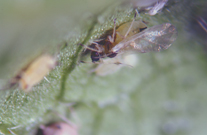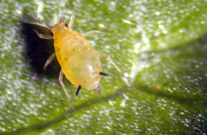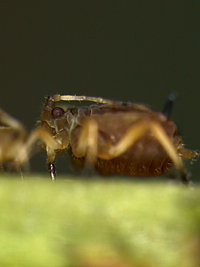| Aphids are soft bodied, pear-shaped insects generally less than 1/8 inch long. They feed by piercing-sucking mouth-parts and often can be found feeding on stem tissue of infested plants. |
|
APHIDS
|
| Major foliage plant hosts of aphids are Aphelandra, Dieffenbachia, Gynura, Hoya and Schefflera. |
| Aphids are soft bodied, pear-shaped insects generally less than 1/8 inch long. They feed by piercing-sucking mouth-parts and often can be found feeding on stem tissue of infested plants. |
| Oleander aphid, Aphis nerii Boyer de Fonscolombe, is a common pest of Hoya, Asclepias, Mandevilla, and Oleander. |
| Frequently the undersides of developing leaves are infested, and feeding causes distorted or stunted leaf development. Alert nursery personnel can often detect white skins shed by the developing aphids (see figure on the left below) on upper leaf surfaces. These shed skins are often the first sign of infestation. The green peach aphid, illustrated in this slide infesting the lower leaf surfaces of Aphelandra is one of the most common species found in commercial greenhouses. These photos are of the green peach aphid, Myzus persicae (Sulzer). |

 |
|
In greenhouses aphid populations, most individuals are wingless, but when colonies become dense, winged forms are produced which disperse within the greenhouse and establish new infestations. Infestations are often first noticed on plants adjacent to greenhouse vents or evaporative cooling pads, as these are the locations where winged migrants frequently gain entry. Under such conditions, winged forms caught in air currents are rapidly spread throughout greenhouses. Under greenhouse conditions aphid populations are all females, with each producing living young. Multiplication rates are greatly increased by the higher temperatures common within greenhouses. These photos are of the melon aphid, Aphis gossypii Glover |
 Photo by Elio
Jovicich
Photo by Elio
Jovicich |
| Aphids have piercing-sucking mouthparts and thus feed my inserting them into the vascular system of the plant. This is how they are able to transmit viruses. |
| Not all wasps
turn the aphid into mummies that look like those picture in photos b& c
above. Some wasps turn the aphids black in color. An adult
wasp still makes a round exit hole in order to emerge. These wasps
are usually an Aphidius species.
|
| More information on aphids can be viewed at "Insect and Related Pests of Flowers and Foliage Plants". Click here to go there now! |
|
LINKS Featured Creatures: Aphis gossypii Glover, Myzus persicae (Sulzer), and Toxoptera citricida (Kirkaldy) |